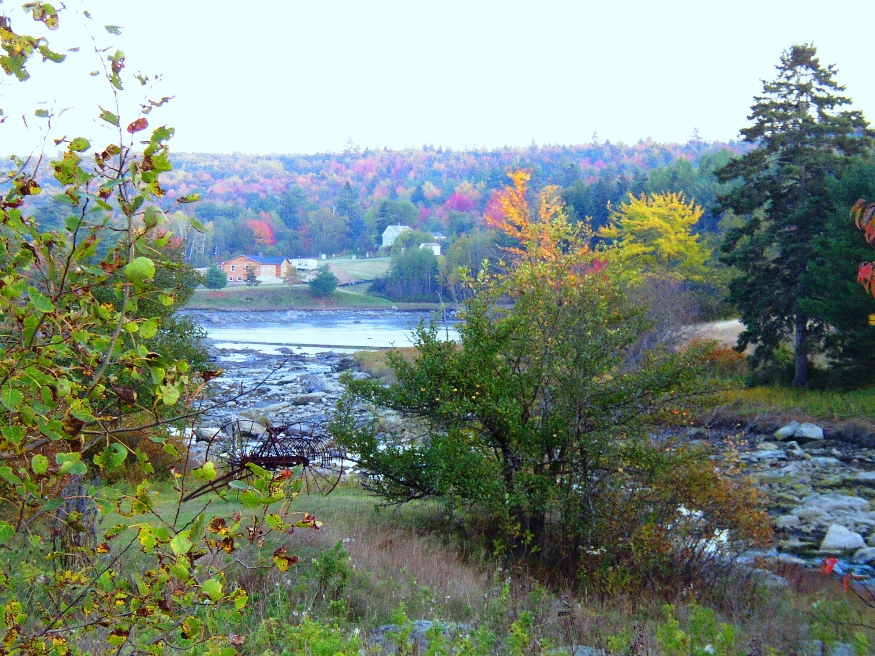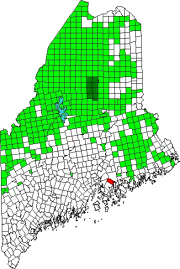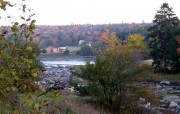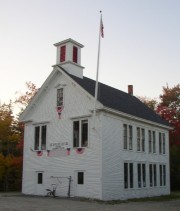| Year | Population |
|---|---|
| 1970 | 623 |
| 1980 | 894 |
| 1990 | 1,004 |
| 2000 | 1,361 |
| 2010 | 1,466 |
| Geographic Data | |
|---|---|
| N. Latitude | 44:29:39 |
| W. Longitude | 68:30:50 |
| Maine House | District 133 |
| Maine Senate | District 7 |
| Congress | District 2 |
| Area sq. mi. | (total) 51.4 |
| Area sq. mi. | (land) 37.2 |
| Population/sq.mi. | (land) 39.4 |
County: Hancock
Total=land+water; Land=land only |
|
 [SUR-ree] is a town in Hancock County, incorporated on June 21, 1803 from the township T6 EPR.
[SUR-ree] is a town in Hancock County, incorporated on June 21, 1803 from the township T6 EPR.
It ceded land to Ellsworth in 1829 and swapped land with Penobscot (1843, 1845).
Once an active fishing, farming and lumbering community, it is now primarily residential with modest tourism and fishing supplementing the local economy.
19th century U.S. Representative Leonard Jarvis lived here.
The town’s Newbury Neck extends over six miles from the mainland, a virtual island surrounded by Morgan Bay and Union River Bay.
This and the Patten Bay area provide scenic attractions for residents and visitors alike.
A group of over 100 amateurs in the Surry Opera Troupe performed in the Soviet Union in 1986.
Surry is just southwest of Ellsworth on Maine Route 172 where it crosses Route 176.
A growing community over the past thirty years, its population jumped thirty-six percent in the 1990-2000 decade, with modest growth in 2010.
Form of Government: Town Meeting-Select Board-Administrative Assistant.
Additional resources
Bonsey, Osmond C. Surry, Maine: An Informal History. Surry, Me. Town of Surry, 2003. [Maine State Library]
Dolan, Anne Robinson. Surry, Maine, 1850-1880: A History of Four Neighborhoods including a guide to the research and composition of local history. 1997. (Thesis (M.A.)–University of Southern Maine, 1997) [University of Southern Maine (Portland), The Albert Brenner Glickman Family Library]
Maine. Historic Preservation Commission. Augusta, Me. Text and photos from National Register of Historic Places.
Varney, George J. A Gazetteer of the State of Maine. 1886. pp. 532-533.
Wasson, Samuel. History of East Surry, Maine 1763-1884. Maine. S. Wasson. 1957? [Maine State Library]
National Register of Historic Places – Listing
Photos, and edited text are from nominations to the National Register of Historic Places researched by Maine. Historic Preservation Commission.
Full text and photos are at https://npgallery.nps.gov/nrhp
Surry Moon Spring Hermitage
Moonspring Hermitage is a historic district located in Surry. Many of the eight buildings are influenced by Japanese architectural design. The Zen Buddhist complex is significant for its Architecture and for Social History. The Japanese influenced design of the buildings, moss garden, and statues reflect a synthesis of Japanese and local Maine forms. The significance of social history is reflected in the mixed influences of Zen Buddhist, eastern philosophy, the back to the land movement, and a significant trend toward alternative lifestyles during the post WWII years and particularly in the 1960s and 70s. The district is owned by a non-profit religious organization and used by a variety of other religious organizations for retreats. The period of significance is from 1970 to 1972, the dates of design and construction for contributing buildings. The period of significance ends in 1972 the date by which major contributing resources in the district were either constructed, under construction, or being designed.
Rural Hall
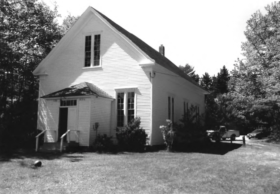 [Surry Road, 1 mile east of Contention Cove] In the eastern section of the small town of Surry, no building is more connected to the community than the Rural Hall. This Italianate style building has been the site of meetings, lecture, classes, shows, and countless dinners since it was built. It is the only large gathering place serving the rural community of East Surry. Throughout its history it has been used for public events, programs and projects.
[Surry Road, 1 mile east of Contention Cove] In the eastern section of the small town of Surry, no building is more connected to the community than the Rural Hall. This Italianate style building has been the site of meetings, lecture, classes, shows, and countless dinners since it was built. It is the only large gathering place serving the rural community of East Surry. Throughout its history it has been used for public events, programs and projects.
Rural Hall was built beginning in 1871, but its genesis lies in the establishment of the Excelsior Sewing Circle which was formed three years earlier. Twenty-two women and fourteen men joined specifically “to raise funds to build a Public Hall”. The industrious members of the Excelsior Circle made and sold enough quilts and clothing to underwrite a substantial portion of the Hall’s construction costs. Throughout the 19th century many churches sponsored Sewing Circle’s or Ladies Aid societies, and during the Civil War these women’s institutions were significant for supplying clothing and bandages for the troops.
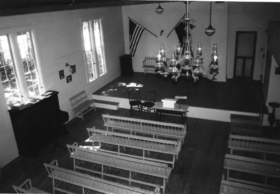 In 1870 residents of East Surry formed a group called the Rural Hall Association . Membership in the association was through the purchase of shares sold to community residents for ten dollars each. The funds raised by the shares were to be used to build the Hall. When sales fell short, twelve East Surry families purchased most of the remaining shares, and the East Surry Farmers Club purchased three shares. The land for the Hall was donated by Samuel Wasson, the founding president of the Association. However, even with the financial support of the community and the local clubs, it was 1877 before the Hall was completed, and several years later before it was fully furnished.
In 1870 residents of East Surry formed a group called the Rural Hall Association . Membership in the association was through the purchase of shares sold to community residents for ten dollars each. The funds raised by the shares were to be used to build the Hall. When sales fell short, twelve East Surry families purchased most of the remaining shares, and the East Surry Farmers Club purchased three shares. The land for the Hall was donated by Samuel Wasson, the founding president of the Association. However, even with the financial support of the community and the local clubs, it was 1877 before the Hall was completed, and several years later before it was fully furnished.
Owned by the Rural Hall Association, the Hall was used extensively by the share holders, including the Sewing Circle and the Farmers Club. It was available to others for a rental fee. A non-denominational Union Sunday School used the building in 1897-1899, and the Good Templars met here between 1892 and 1899. The East Surry Farmers Club was the first of agriculturally oriented associations to make their home in the Rural Hall. This Farmers Club was a gathering of local agriculturalists and community members who met to discuss agricultural practices, experiment with new breeds and techniques, or to develop cooperative solutions to common farming problems.
The patrons who have used Rural Hall represent a cross section of the common social organizations found in the towns and cities throughout Maine, although in many cases the Sunday schools, Farmer’s Clubs and Good Templar’s met in different buildings. The group with the longest association with the building, besides the Association itself, is the East Surry Garden Club. Founded in 1937, the Garden Club still meets each month at the hall, and uses the facility for its flower shows and annual quilt show. The Hall also hosts numerous meetings, productions and events each year and is rented by residents for gatherings and celebrations.* [Christi A. Mitchell photos, 2004]
Date listed: 12/9/2021
Period of Significance: 1970 – 1972
Moonspring Hermitage is a historic district located in Surry, Hancock County, Maine, that is eligible for listing in the National Register at the local level of significance. Many of the eight buildings are influenced by Japanese architectural design. The Zen Buddhist complex is significant for its Architecture and for Social History. The Japanese influenced design of the buildings, moss garden, and statues reflect a synthesis of Japanese and local Maine forms. The significance of social history is reflected in the mixed influences of Zen Buddhist, eastern philosophy, the back to the land movement, and a significant trend toward alternative lifestyles during the post WWII years and particularly in the 1960s and 70s. The district is owned by a non-profit religious organization and used by a variety of other religious organizations for retreats. The property meets Criteria Consideration A: Religious Properties due to its significance for Japanese styled Architecture and Social History trends which are not associated with the district’s religious uses. The period of significance is from 1970 to 1972, the dates of design and construction for contributing buildings. The period of significance ends in 1972 which reflects the 50-year consideration of the National Register and is also the date by which major contributing resources in the district were either constructed, under construction, or being designed.
In 2015, after three years of work, all windows in the historic Rural Hall have been restored. Neighbors worked to restore and reinstall all 18 very large windows. [https://www.ellsworthamerican.com/maine-news/volunteers-restore-windows-at-surrys-rural-hall/] (accessed June 18, 2018]
Surry Town Hall
[1217 Surry Road] The Surry Town Hall has served as a community building, church, and as town hall since 1844. It was originally built in East Surry as the Town House in 1828, but was later sold to the Union Meetinghouse Society and moved into Surry Village. The town retained use of the building during this period. After it ceased to be used as a church it reverted back to municipal functions.
Since 1983 the building has been the home of the Surry Historical Society. The Surry Town Hall was erected in 1828 by the town to serve as a municipal building. As originally built it was a fairly simple, three bay, gable front building with minimal ornamentation. As with similar halls in Maine towns, a hall was needed for town events and to provide a venue for the town’s elected officials to conduct meetings, as well as a place where towns people could gather to vote.
Authorizing such a building did not come easily, however. Although the proposed location of the Town House was a matter of intense debate, it was eventually located at the head of Contention Cove, approximately a mile and a half to the east of its current location. However, in 1829 the eastern portion of Surry was set off to neighboring Ellsworth. This was the last realignment of a decades long dispute regarding the borders of the two towns. As a result the Town House was on the far eastern edge of town, which did not sit well with many of the town’s residents.
Thus, in 1844 the Town House was sold to the Surry Union Meeting Society, but the town “reserved the right to hold its town meeting” in the building. The building was renamed the Surry Union Meeting House and preparations were made to move it to a more central location in town. The Surry Town Hall was used for voting, annual town meetings and Selectmen’s meetings until 1978. [See photo above.]
Source: United States. Department of the Interior. National Park Service. https://npgallery.nps.gov/pdfhost/docs/nrhp/text/08000993.PDF (accessed March 9, 2017)
Surry Village School
Surry Village School is a two-story, two-room schoolhouse. The gable-front, Italianate-style building is significant for its association with patterns of education. The building is the largest school built in Surry prior to the 1952 construction of the Surry Elementary School. Surry had as many as eight other school districts with one room schools prior to 1933 when the student population, including primary schoolers, was consolidated into this school. It also served as the town’s only high school during the years with high enrollment.
The school was built in 1872 by local carpenter Jesse Ray and modified throughout its use as a school to accommodate evolving trends in education. The interior wood wall covering over the original plaster and added east windows occurred during the period of use and reflect the evolution of educational practices and the distinct characteristics of a schoolhouse. 1952 was last year of its use as a school.


